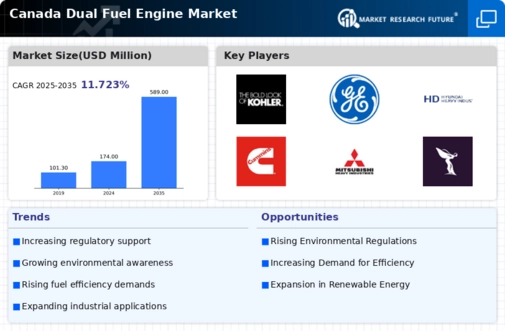Rising Fuel Prices
The dual fuel-engine market in Canada is significantly influenced by the volatility of fuel prices. As traditional fuel costs fluctuate, consumers and businesses are increasingly seeking alternatives that offer cost savings. Dual fuel engines, which can operate on both conventional fuels and alternative sources, provide a viable solution to mitigate the impact of rising fuel expenses. In recent years, the price of gasoline has seen substantial increases, prompting a shift in consumer behavior towards more economical options. The dual fuel-engine market stands to gain from this trend, as it offers flexibility and potential savings, making it an attractive choice for fleet operators and individual consumers alike.
Advancements in Fuel Technology
The dual fuel-engine market in Canada is benefiting from ongoing advancements in fuel technology. Innovations in alternative fuels, such as biofuels and hydrogen, are enhancing the performance and efficiency of dual fuel engines. These developments are crucial as they provide viable options for reducing emissions and improving energy security. The dual fuel-engine market is poised for growth as manufacturers integrate these advanced fuel technologies into their offerings. Furthermore, research and development efforts are likely to continue, focusing on optimizing engine performance and expanding the range of compatible fuels, thereby attracting a broader customer base.
Increasing Fuel Efficiency Standards
The dual fuel-engine market in Canada is experiencing a notable shift due to the implementation of stringent fuel efficiency standards. These regulations compel manufacturers to innovate and adopt dual fuel technologies that optimize fuel consumption. As a result, vehicles equipped with dual fuel engines are becoming increasingly attractive to consumers and businesses alike. The Canadian government has set ambitious targets to reduce greenhouse gas emissions, aiming for a 30% reduction by 2030. This regulatory environment encourages the adoption of dual fuel engines, which can utilize cleaner fuels alongside traditional options, thereby enhancing overall efficiency. The dual fuel-engine market is likely to benefit from these evolving standards, as manufacturers strive to meet compliance while appealing to environmentally conscious consumers.
Government Incentives for Alternative Fuels
The dual fuel-engine market in Canada is bolstered by various government incentives aimed at promoting the use of alternative fuels. These incentives, which may include tax breaks, grants, and subsidies, encourage both manufacturers and consumers to invest in dual fuel technologies. The Canadian government has committed to supporting the transition to cleaner energy sources, with initiatives designed to reduce reliance on fossil fuels. For instance, programs that subsidize the installation of dual fuel systems in commercial vehicles are becoming more prevalent. This supportive framework enhances the attractiveness of the dual fuel-engine market, as it lowers the financial barriers for adoption and encourages innovation in cleaner technologies.
Environmental Awareness and Sustainability Trends
The dual fuel-engine market in Canada is increasingly shaped by heightened environmental awareness among consumers and businesses. As sustainability becomes a core value, there is a growing demand for technologies that reduce carbon footprints. Dual fuel engines, which can utilize cleaner fuels, align well with these sustainability goals. The dual fuel-engine market is likely to see a surge in interest as consumers prioritize eco-friendly options in their purchasing decisions. This trend is further supported by educational campaigns and initiatives that promote the benefits of dual fuel technologies, potentially leading to increased market penetration and acceptance across various sectors.

















Leave a Comment